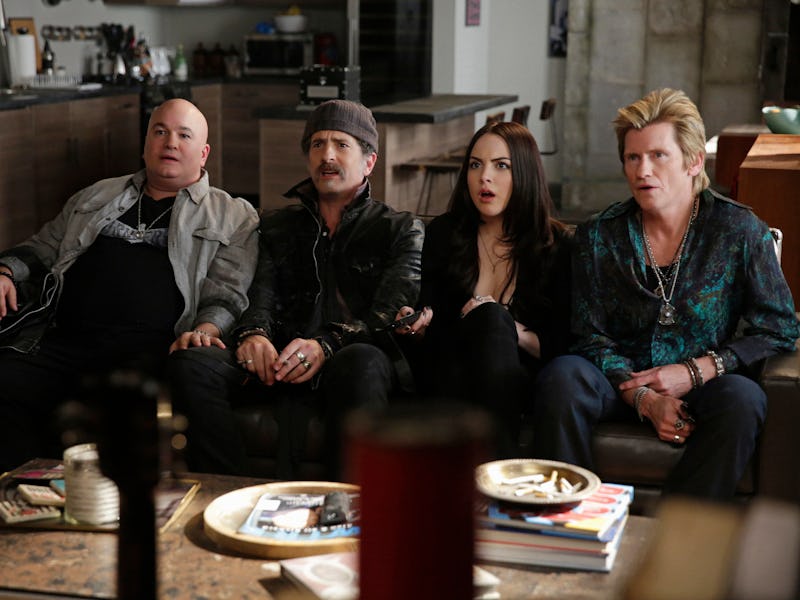Sex&Drugs&Rock&Roll' Season 2 Is a Metaphor for Our Inconsequential Lives
FX's unlikely rock'n'roll comedy of manners returns, to force us to take a long hard look at ourselves -- all over again.

“To everything, there is a season,” the Byrds once sang. The television-reliant — in an era when programming ideas must be tried and tried again in followup seasons — feel their age when the next season of a show, which they could have swore just concluded, rears its head again. Increasingly rare is the sensation of having “waited forever” for TV gratification, and even rarer is the gratification itself. More and more frequently, though, viewers are confronted with reprise seasons of shows they still can’t believe were allowed to be made.
No, I’m not talking about Turn: Washington’s Spies. I’m referring to FX’s mumblecore-y, behind-the-scenes music procedural Sex&Drugs&Rock&Roll, which a little less than a year after the premiere of its first season, is returning to the air on June 30th.
FX probably cultivates the best original programming roster on cable at the moment. So Sex&Drugs&Rock&Roll came bearing like a failure waiting to happen: a favor the network did for Denis Leary following the long-running success (seven seasons!) of his firefighter drama Rescue Me, which came at a time when the network’s studio didn’t have a whole lot else going for it.
After sitting through the ten episodes of S&D&R&Rs first season, you’d probably feel the same way. The story of Johnny Rock — Leary’s washed-up, deluded lead singer of ‘90s-famous cock-rock band The Heathens — his former bandmates (John Corbett, Bobby Kelly, John Ales), his wife/backing singer Ava (Elaine Hendrix), and his daughter and aspiring singer Gigi (Elizabeth Gillies) seemed to both interact with the modern world (you know, iPhones, Lady Gaga and stuff) while being steeped in a romanticized view of a rock’n’roll past that never occurred. The cultural references seemed misplaced, or five to eight years old; the word “douchebag” cropped up as much as “the”; the original songs — courtesy of The Afgan Whigs’ Greg Dulli, whose name is frequently (read: gratuitously) inserted in the script — were phoned-in on an almost avant-garde level.
As you eased into it (if you somehow decided you should), you realized that Sex&Drugs&Rock&Roll was clearly made for about 2 dollars. Why not, then, push the show to Season 2? Hype tends to built for low-stakes, sleeper shows going into their second season, and business for FX has been booming recently.
So Leary, Corbett and the gang are charging into Season 2 and delivering more of the same. If anything, easing up on what little degree of conflict was there in the first place, and embracing the loopy, lengthy scenes of pseudo-improvisatory banter. In fact, it seems even more loosely plotted, more felt out on the spot, more episodic.
A few episodes in, this suits the show, in some sense. S&D&R&R is, and always will be, an odd, odd phenomenon: something with exactly no reason to exist, with an ambiguous commitment to any particular aesthetic ethos or subject. Its most interesting element may be its very sloppiness. It recognizes that there is no reason to religiously tune in every week to show without conflict. A better bet for it, perhaps, is to maintain a episodic, sitcom-y format.
Just under the surface, however, there is an emptiness and a sadness to S&D&R&R, both unintended and embedded into the plot of the show. “Bro, we’re getting old,” says Bam Bam in Episode 2 — for a flash, the voice of reason. Without delving into the few moments on this show could be considered “spoilers,” suffice to say that Johnny is struggling with issues from his past here — ones that make him feel as if he needs to, once again, attempt to take his own course away from The Assassins. Will he actually abandon them? No, the ties that bind are strong, and the show’s creators are too trigger-happy to return our band of rude mechanicals to the studio, where they bang out sketches of songs based, inevitably, around one seminal “ooo.”
But is the fabric of life really disruption? Isn’t it, more often, the absence of it? “Bro, we’re getting old,” quoth Bam, because as S&D&R&R, life never really changes. Small breakthroughs and catharses modify the trajectory just a bit, but usually cancel each other out; you turn a pawn into a queen, but you’ve already played yourself by losing your bishops.
As Sex&Drugs&Rock&Roll’s players pursue their holy grails of the moment — lesbian experimentation, lasting more than 7 seconds in a threesome, writing the next “Hamilton,” creating a whiskey brand inspired by Sammy Hagar’s Cabo Wabo tequila — one feels that any sense of progression on the show is illusory. When Johnny pops a bottle in the studio, or Bam and Rehab bite each other’s heads off about a professional choice for their new side project, there are moments of faint Season 1 déjà vu. One realizes how easy it can be to repress memories when it’s more convenient, and in turn, never truly learn from one’s mistakes.
Going into Season 2, there’s a sense that, perhaps, more than any other show on television, Sex&Drugs&Rock&Roll mimics the quiet rhythms of life, the ones we usually deem too tedious to speak of, except to a well-paid therapist.